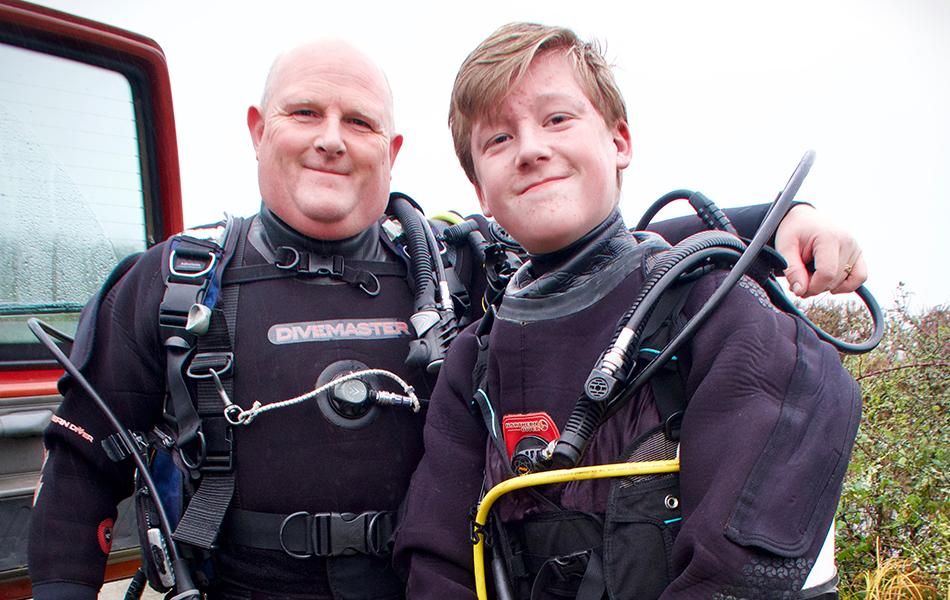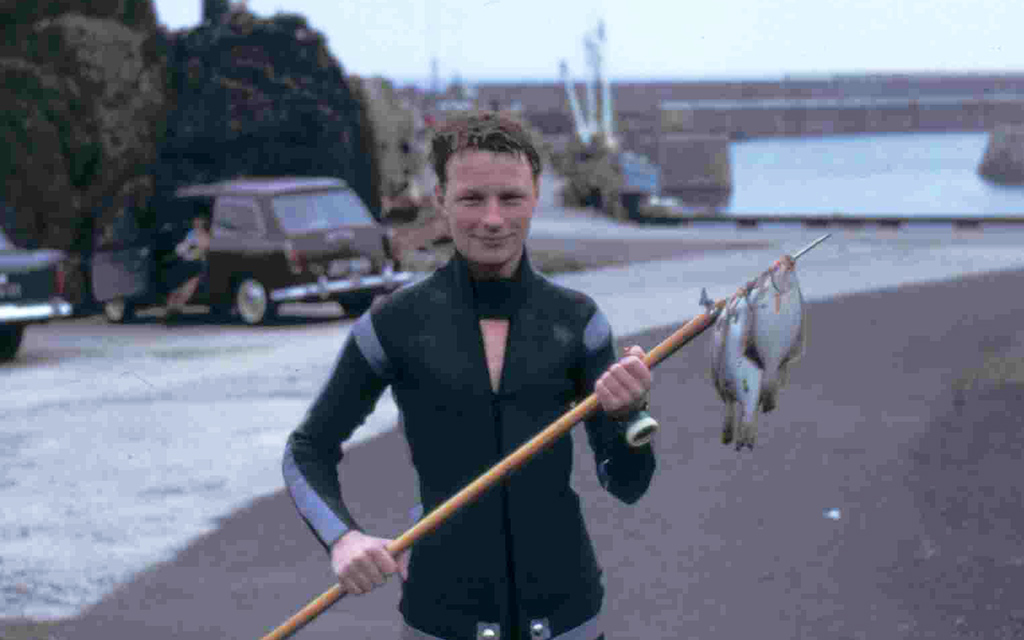
Allan Carr with home-made wetsuit, new and expensive Draeger depth gauge, and carrying his bank holiday lunch
BSAC member Allan Carr learned to scuba dive back in the sixties. He recalls what diving was like, including early dive equipment.
Beatlemania was sweeping the nation, Harold Wilson was British Prime Minister, and the moon landing was still three years away. Meanwhile, in St Abbs I was a young BSAC member with Tyneside SAC and enjoying the new sport of scuba diving.
August bank holiday, 1966
I used to dive with Tyneside Branch during the summer break from university, and remember our trip to St Abbs over August bank holiday 1966. Divers were a rarity in those days so we attracted a lot of interest. The big difference then was that parking was easier. The nearest air-filling station was in Eyemouth and this caused us some attention from the local Constabulary. There was a burglary at a local bar and a lot of bottles of spirits were stolen. When somebody heard one of the divers say that the bottles had been taken to Eyemouth, the police immediately jumped to conclusions.
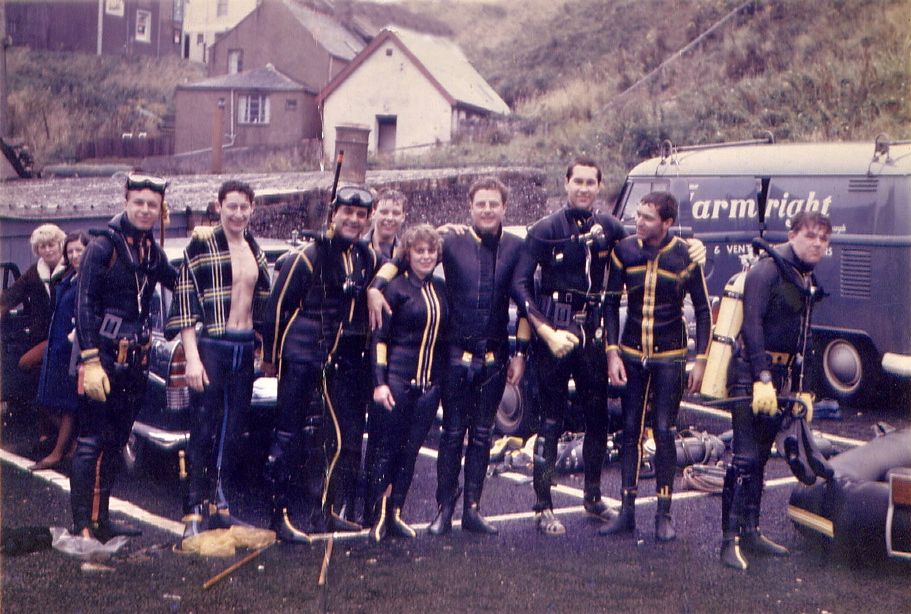
St Abbs, 1966 standing left-right: Barry Shepherd (Allan's usual buddy at Tyneside), unknown, Stan Holford (the master lobster catcher), Allan, Brian Walker and his wife (Brian was DO), unknown, unknown, Bill Smith
There were no dedicated dive boats at that time so most diving was done from the shore. What boat diving that did happen was on local inshore fishing boats. I was using a slimline 40cuft cylinder, equivalent to a modern 5-litre cylinder. It was amazing how long we made them last though I must admit we didn’t bother about surfacing with a healthy reserve. Because the cylinders were small, we didn’t waste air: snorkel out to the shot, straight down fast and don’t fin around more than you have to. Even today, my Surface Air Consumption (SAC) is in single figures.
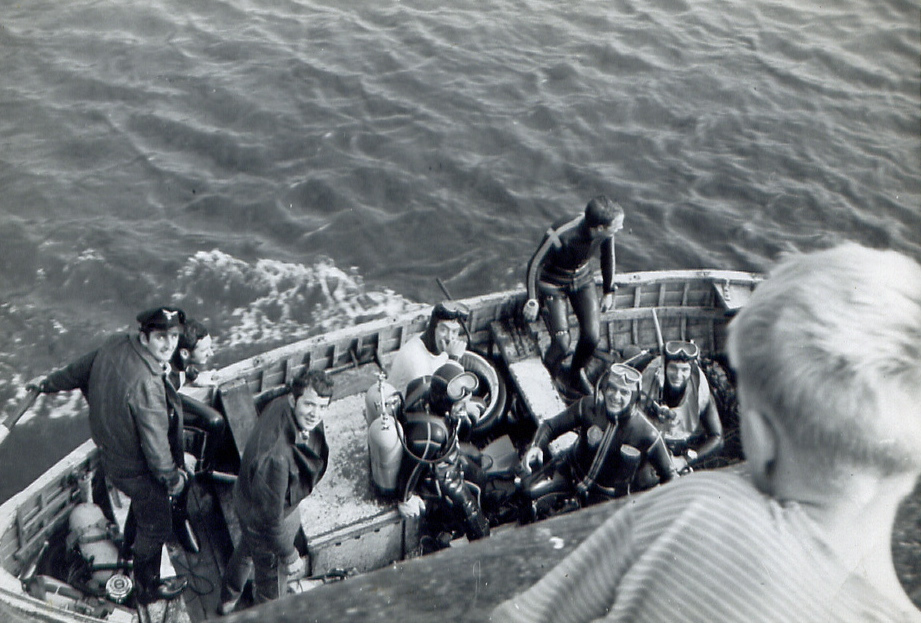
Boat diving in 1966
My beginnings
I had started diving in September 1964 in the week of my 17th birthday. After doing initial training with Tyneside Branch, I went to university in Bristol and immediately joined the university diving club. The uni club was not a BSAC branch but had close contact with Bristol No. 3 Branch and I soon moved over to join them since there was a lack of experienced divers in the uni club and I wanted to extend my experience.
Equipment in the 60’s
Back in the mid-60’s sports diving was very much in its infancy and equipment was very basic. Twin hose valves were still the most common but single hose valves were beginning to gain popularity. My first valve was a second-hand SG Mistral, a single stage valve. You could tell when the cylinder pressure was getting low because you had to suck harder!
Cylinders were a much lower pressure – 1800PSI/120 bar was the norm. Capacity was measured in terms of the volume of air they held in cu. ft. As a comparison, a modern 232 bar 12-litre cylinder is around 100 cuft. There were still a lot of ex-military cylinders around – 25 cuft ones known as Tadpoles. Another was the 80cuft Dustbin, about the size of a 20-litre modern cylinder and incredibly buoyant. The most common ’modern’ cylinder was a slimline 40 cuft which were often twinned. The more adventurous divers were moving on to twin 65s, the largest available at that time.
The only drysuits available then were the ex-navy ones with no suit inflation. I used some on dives Bristol Branch did for the police and came up with pinch bruises.
Do-it-yourself dive gear
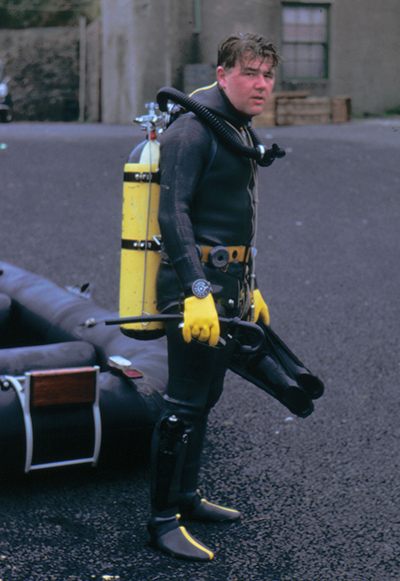
Bill Smith of Tyneside SAC
It was common for divers to make bits of kit themselves. My first wetsuit was a DIY kit which came as a large sheet of neoprene, a brown paper pattern, tape and glue. It was 3/16th inch (4.75mm) single skinned – the inside was open celled. To put it on dry required copious amounts of French chalk. When damp, we used washing-up liquid to slide in – at least it was easy to get out of your suit and you came up clean.
Buoyancy compensators like the Fenzy Mk1 were starting to appear on the scene, but were so expensive they were only for the more affluent divers. Prior to that we used to aim for neutral buoyancy at deco depth. On deep dives, normally wrecks, we would have some weights which we could leave at some place on the bottom and we lined off, home-made reel of course (BSAC even published a pattern for one). Surfacing was a matter of finning hard.
I made my first ABLJ (Adjustable Buoyancy Lifejacket) from a Davis submarine escape jacket bought from a military surplus shop. The jacket was fairly thin so I made a heavy canvass over-jacket which I dyed orange. A PVC plumbing 90-degree bend, an old twin hose and mouthpiece (a very old one with no non-return valves in it), turned down old halfpennies with holes drilled in them glued in place with washers made from car tyre inner tubes completed it. Inflation was from a small NO2 acquired from BOC, filled using an adapter to connect to the pressure gauge hose. I used this for several years.
There were no dive computers of course and a depth gauge and watch were used for monitoring deco requirements. Even diving watches were expensive and one of the club members used to make housings which would hold a normal watch. Ascent rate was monitored by watching your small bubbles. This is around 15m a minute – rather fast by modern standards.
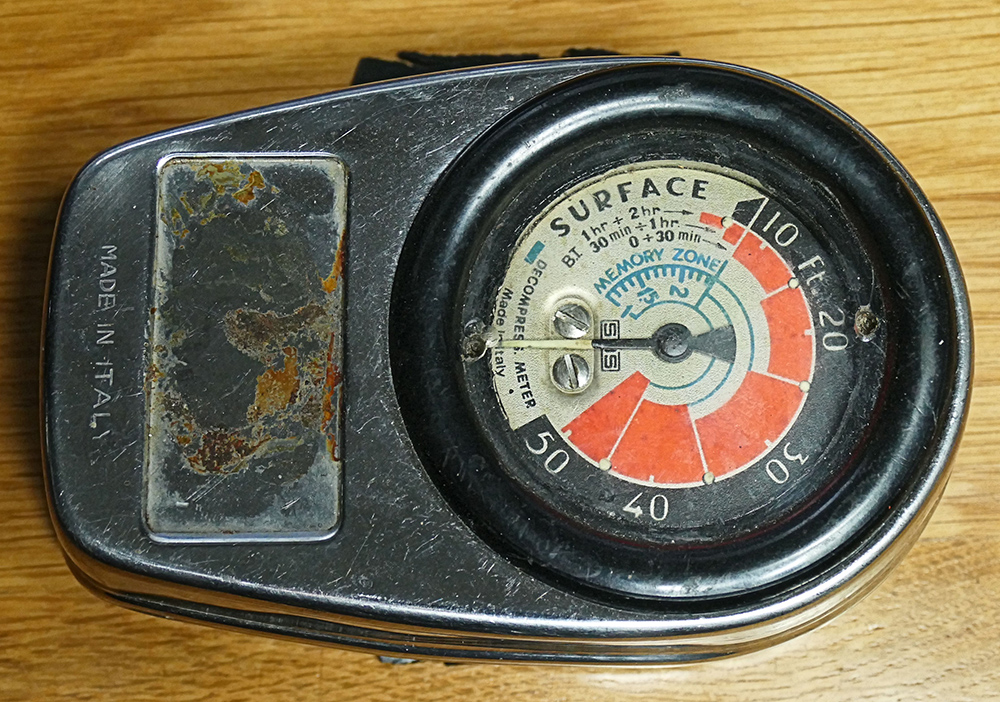
Allan's SOS Deco Meter (no longer working) - forerunner to today's dive computers
There was no Alternate Source (AS). Your backup was buddy breathing from your buddy’s regulator. This was practised regularly, even doing it with blacked-out masks in the pool.
Masks had a neoprene skirt which was rather stiff and they tended to leak, so often had a drain valve at the bottom to save constantly having to clear them.
Diving today
Diving now is much easier, more comfortable and potentially safer. There is less of a requirement to be fit because less swimming is involved.
In many ways, diving now appears to be more risk averse but I used the term potentially because in spite of the lack of backup safety features and doing diving that would now make a lot of modern divers think we were aiming for a Darwin Award (I dived the Markgraf at Scapa on a single 75cuft cylinder – equivalent to a 9-litre and have a number of 60m+ air dives under my belt), no-one I dived with then was ever involved in a fatal or even serious incident.
I think the reason was that we were very aware that we were in an alien environment and always alert to something going wrong. Safety backup features can breed complacency. Brain Walker the Tyneside DO at the time had a saying: ‘Diving is perfectly safe as long as you remember it’s dangerous’ – something I always remind my trainees of. He had another saying – always follow the BBC approach – Be Bloody Careful!


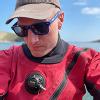 Author: Patrick Holliday | Posted 02 Nov 2023
Author: Patrick Holliday | Posted 02 Nov 2023



